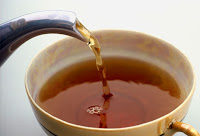Travel light, live light, spread the light, be the light.
- Yogi Tea quote
Types of Tea
Green Tea - has the most potent antixodants; is somewhat cooling; is the least caffeinated
White Tea - delicate (because made from buds); the least processed; a cooling tea; has the most antioxidants and slightly more caffeine than green tea
Oolong Tea - has fewer antioxidants (because it's partly oxidized); tends to raise spirits and inspire, whereas green and black tea are more grounding; somewhere in between warming and cooling; has more caffeine than green or white tea but less than black
Black or Red Tea - 100% oxidized; has less-potent antioxidants (or flavenoids); a warming tea
 |
| image from McDuff's Tea Room |
Active Ingredients in Tea
Antioxidants - These molecules prevent free radicals from causing cell decay, deterioration, and destruction. They help us live longer and enjoy greater health.
EGCG (epigallocatechin gallate) - Has been found to be over twenty times more powerful than vitamin E in neutralizing the lipids that create free radicals. One cup of tea is the antioxidant equivalent of a cup of blueberries. It's been shown to relax blood vessels, inhibit blood clots, improve blood cholesterol levels, block the production of an enzyme (urokinase) that accelerates tumor growth, and assists in the production of healthy DNA.
Theaflavins and Thearubigens - Found in oolong and black tea, they come into contact with the enzyme polyphenol oxidase during the rolling process and are joined together with it. These oxidized polyphenols seem to have a calming effect on digestion.
Gallic Acid (GA) - An antioxidant with anti-mutagenic, anti-carcinogenic, and anti-inflammatory properties.
Theanine - A rare amino acid found in tea and one form of mushroom. L-theanine promotes relaxation without drowsiness by stimulating GABA and serotonin (inhibitory neurotransmitters) and dopamine, a neurotransmitter that reduces blood pressure and enhances mood. L-theanine also appears to improve memory and learning performance, and it may reduce PMS symptoms. Theanine also primes the immune system against bacteria, viruses, and fungi, and it appears to exhibit anti-tumor activity.
Caffeine Content
Black tea contains roughly half the amount of caffeine found in coffee. Green, white, and oolong tea usually have lower amounts of caffeine: oolong has more than white and white has more than green.
If a stranger say unto thee that he thirsteth, give him a cup of tea.
-Confucius
Resources
Blofield, The Chinese Art of Tea (1985)
Chow and Kramer, All the Tea in China (1990)
Mitscher and Dolby, The Green Tea Book (1998)
Pratt, New Tea-Lover's Treasury (1999)
Tizer and Fellman, Tea Here Now (2005)
A special thanks to Ms. Fellman for her delightful and informative presentation, "Tea Here Now" (from which this information is derived), at Miraval.
No comments:
Post a Comment